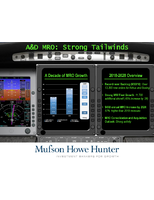Video Imaging System aids minimally invasive surgery.
Press Release Summary:

With 1588 AIM Platform, clinicians can visually differentiate critical anatomy across array of minimally invasive surgical procedures, reducing risk to patients. Connected surgical video system seamlessly integrates 5 unique imaging modalities to optimize visualization across laparoscopy, arthroscopy, urology, gynecology, ENT, and GI specialties. Modalities include Infrared Illumination System, Endoscopic Near Infrared Visualization, Clarity, Dynamic Range Enhancement, and Desaturation.
Original Press Release:
Stryker Introduces New Advanced Imaging Modalities to Minimally Invasive Surgery with the 1588 AIM Platform
SAN JOSE, Calif., -- Stryker Endoscopy, a division of Stryker Corporation, announced today the launch of the 1588 AIM Platform, a connected surgical video system that enables clinicians to visually differentiate critical anatomy across an array of minimally invasive surgical procedures. The 1588 AIM platform is designed to reduce risk to patients by enabling surgeons to distinguish, safeguard and document critical anatomy.
"As surgeons, we need to work hard to provide the best possible outcomes for our patients," explained Dr. Scott Melvin, Director of General Surgery at Montefiore Medical Center. "This new platform allows us to see critical anatomy in real-time, with a simple touch of the button on the camera head."
The 1588 AIM Platform is the first visualization system to seamlessly integrate five unique imaging modalities into one platform designed to enhance visualization of patient anatomy across six surgical specialties (laparoscopy, arthroscopy, urology, gynecology, ENT, and GI).
--Â IRIS. Infrared Illumination System. IRIS is a visualization technology designed to reduce the risk of ureteral damage, which has a documented incidence rate of 0.3-1.8% in lower pelvic procedures.(1, 2)
--Â ENV. Endoscopic Near Infrared Visualization. ENV is designed to reduce the risk of common bile duct injury during laparoscopic cholecystectomies by safeguarding critical anatomy and reducing the risk of anastomotic leaks during gastric bypass and sleeve gastrectomy.
--Â Clarity. Clarity is a real-time video enhancement device designed to improve visualization of anatomy by enhancing tissue level detail and intra-body structures. This technology helps surgeons see through smoke and murky fluid, thereby improving image quality by up to 48%.(3)
--Â DRE. Dynamic Range Enhancement. DRE is designed to improve lighting in the visual field by brightening dark and posterior compartments, allowing surgeons to operate in otherwise poorly lit environments.
--Â Desaturation. Desaturation decreases the saturation of color in the image, which is a preference that varies by surgeon and specialty.
By enabling enhanced visualization of critical anatomy with advanced imaging modalities, the 1588 AIM Platform is designed to allow surgeons to operate with greater confidence. "The reality is that this technology brings a lot to the table," stated Dr. Santiago Horgan, Chief of Minimally Invasive Surgery at University of California, San Diego. He added that for him, "It simplifies surgery and puts greater focus on patient care."
The 1588 AIM Platform provides the opportunity for caregivers to focus on highest quality patient care, improved patient outcomes, and sustainable operational costs. For more information on the 1588 AIM Platform, please visit our website at www.StrykerAIM.com.
About Stryker
Stryker is one of the world's leading medical technology companies and, together with our customers, we are driven to make healthcare better. The Company offers a diverse array of innovative products and services in Orthopaedics, Medical and Surgical, and Neurotechnology and Spine that help improve patient and hospital outcomes. Stryker is active in over 100 countries around the world.Please contact us for more information at www.stryker.com.
Media Contacts:
Kara Rasmussen
408.754.2884
Sr. Marketing Communications Manager
Kara.Rasmussen@stryker.com
Samantha Ross
408.679.4382
Sr. Marketing Communications Associate
Samantha.Ross@stryker.com
(1) Parpala-Sparman T, Paananen I, Santala M, Ohtonen P, Hellstrom P.Increasing numbers of ureteric injuries after the introduction of laparoscopic surgery. Scand J Urol Nephrol. 2008;42(5):422-427 [PubMed.
(2 )Anand et al. "Utility of intraoperative cystoscopy in detecting ureteral injury during vaginal hysterectomy". Female Pelvic Med Reconstr Surg. 2015 Mar-Apr;21(2):70-6.
(3 )Data on File. Internal Reference. TR16211.




